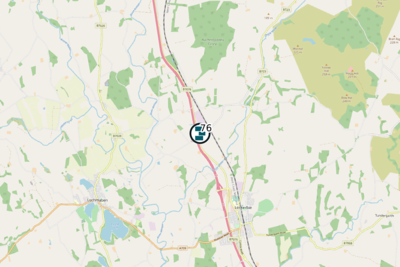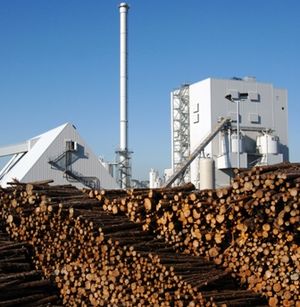Stevens Croft: Difference between revisions
Arctellion (talk | contribs) No edit summary |
Arctellion (talk | contribs) No edit summary |
||
| Line 16: | Line 16: | ||
Construction of the facility at Steven's Croft not only included the biomass plant but a fuel processing facility and 26km of underground electrical cable connecting the plant to Chapel Cross electriclal sub-station<ref name="SC" />. The fuel processing facility was designed to blend all the various sources of fuel mentioned above into one homogeneous material. It includes up to 14 days of round wood storage, a facility for reception of pre-chipped fuel, up to 6000m3 of covered chipped fuel storage, a round wood chipping facility, fuel reclamation and forwarding equipment with systems for final preparation of the fuel before delivery to the power plant.<ref name="SC" /> | Construction of the facility at Steven's Croft not only included the biomass plant but a fuel processing facility and 26km of underground electrical cable connecting the plant to Chapel Cross electriclal sub-station<ref name="SC" />. The fuel processing facility was designed to blend all the various sources of fuel mentioned above into one homogeneous material. It includes up to 14 days of round wood storage, a facility for reception of pre-chipped fuel, up to 6000m3 of covered chipped fuel storage, a round wood chipping facility, fuel reclamation and forwarding equipment with systems for final preparation of the fuel before delivery to the power plant.<ref name="SC" /> | ||
The facility also provides electricity to its fuel provider AW Jenkinsons and | The facility also provides electricity to its fuel provider AW Jenkinsons and supplies heat to the neighbouring sawmill, James Jones and Sons<ref>[https://www.eonenergy.com/About-eon/our-company/generation/our-current-portfolio/biomass/stevens-croft/ E.ON]</ref>. | ||
==Plant== | ==Plant== | ||
Revision as of 10:20, 7 April 2020
| Error: no local variable "site" has been set. Error: no local variable "status" has been set. | |
 See Biomass EfW → page for a larger UK Wide map. | |
| Operator | Error: no local variable "operator" has been set. |
| Capacity | Error: no local variable "capacity" has been set. MWe |
| Feedstock | Error: no local variable "mainfeed" has been set. |
| EPR (Waste Licence) | Error: no local variable "epr" has been set. |
| ROC | Error: no local variable "roc" has been set. |
| CfD | Error: no local variable "cfdcap" has been set. |
| CHP | Error: no local variable "chp" has been set. |
Operators Annual Report
Input Data
| Year | Wood | Litter | RDF | Other | Total |
|---|
Output Data
| Year | IBA | IBA %ge of Tot IN | APC | APC %ge of Tot IN |
|---|

Summary
A Biomass Waste EFW CHP facility based on 480,000 tonnes per annum of Wood Waste generating 44MWe to the grid [1]. The plant was developed and is owned by E.ON UK and cost an estimated €132m[2].
Steven's Croft in Lockerbie Scotland, has an output of 44 MWe and 6.5 MWth, the facility supplies c. 70,000 homes, displacing 140,000 tonnes of greenhouse gases[1].
The feedstock for the plant includes forest wood and agricultural residues, urban wastes and energy crops, all of which are readily available in the local area, the feedstock comprises[1]:
- 60% sawmill co-products and small roundwood
- 20% short rotation coppice (willow)
- 20% recycled fibre from wood product manufacture.
Construction of the facility at Steven's Croft not only included the biomass plant but a fuel processing facility and 26km of underground electrical cable connecting the plant to Chapel Cross electriclal sub-station[1]. The fuel processing facility was designed to blend all the various sources of fuel mentioned above into one homogeneous material. It includes up to 14 days of round wood storage, a facility for reception of pre-chipped fuel, up to 6000m3 of covered chipped fuel storage, a round wood chipping facility, fuel reclamation and forwarding equipment with systems for final preparation of the fuel before delivery to the power plant.[1]
The facility also provides electricity to its fuel provider AW Jenkinsons and supplies heat to the neighbouring sawmill, James Jones and Sons[3].
Plant
Construction of the plant began in October 2005 with the plant entering commissioning in Autumn 2007 [2]. Construction was carried out by a Siemens/Kvaerner consortium with the boiler being a Kvaerner Power Bubbling Fluidised Bed power boiler, fuel handling and flue gas cleaning equipment[2]. The boiler conditions were designed to allow the best efficiency at 537°C, 137Bar with a capacity to raise 16 MWth of energy. The high steam conditions dictate the need for specialist corrosion resistant materials in the high temperature components and to control fuel quality.[1]
Siemens provided overall coordination, engineering and project management as well as the civil works and electrical and I&C equipment[2].
The power plant can reach full output even with high moisture fuels. It is able to burn a maximum of 20% recycled wood (limited by Planning and IPPC) and a maximum of 20% short rotation coppice. Moisture content for the plant is between 46% and 58%, with a design blend of 53%[2].
